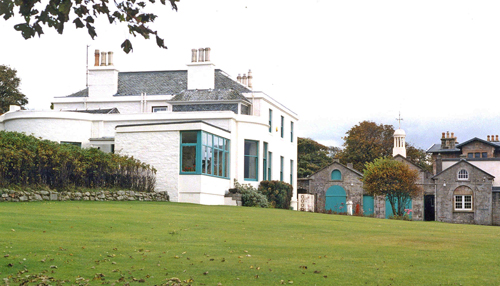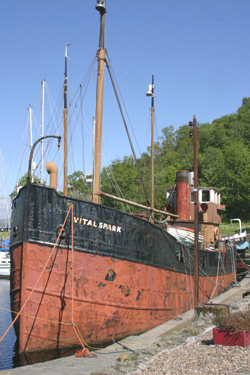AUTHOR Neil Munro’s 67 years of life began on June 3 1863 in Inveraray and ended in Helensburgh, in whose east end he spent the last years of his life until he died on December 22 1930.
While a resident of the town he lived in the seafront mansion Cromalt (below left), 148 East Clyde Street, a fine house which was built in the 18th century.
The fact of his illegitimate birth was hardly a rarity amongst the servant classes in Victorian times — rumour suggests his father was a family member of the Duke of Argyll.
His mother, Ann Munro, was a kitchen maid in Inveraray and Neil himself was brought up a barefoot boy, speaking both Gaelic and English.
However his inauspicious beginnings did not stop him becoming an author of note and one of Helensburgh’s most famous inhabitants. Nor did the fact that his education lasted only until he was aged 13.
After he left Inveraray School he worked in the office of the Sheriff Clerk of Argyll, before beginning his writing career in journalism in 1881, rising quickly to become assistant editor of the Evening News in Glasgow.
After four years he left journalism to dedicate himself for a dozen years or so writing poetry, short stories and novels — it was about this time that he moved firstly to Greenock and then in 1918 to Helensburgh.
A short story collection, The Lost Pibroch and Other Sheiling Stories, appeared in 1896 and his first novel John Splendid was published in 1898.
This was followed by a number of historical novels all exploring the impact of change within the Highlands. Doom Castle (1901) and The New Road (1914) focus on the contrast between the Highlands and the South of Scotland, the Gaelic speakers and the English.
He voiced, through the themes and the characters, his own regrets that the influence of the South was altering the ways of the Gaelic-speaking North.
Both his mother and grandmother were Gaelic speakers and Munro’s affection for the language is perceptible. It is used for terms of endearment and emotion and runs throughout the novels.
He writes of the Highlands as one who laments the changes while understanding the benefits, and his novels were acknowledged as prime models of the genre.
Later he wrote on European art, Glasgow policies and the Highlands, providing a first hand commentary on the Scottish social situation. He saw Glasgow as being the second city of the Empire, emphasising the importance of the Clyde ships, Charles Rennie Mackintosh and the Great Exhibition.
During this period he continued writing humorous stories for the Evening News, as author of ‘The Looker-On’ column, giving a light-hearted weekly social comment on the times.
The sketches included the antics of Master Mariner Para Handy sailing his puffer, the Vital Spark, up and down the west coast of Scotland, along with his mate Dougie, Hurricane Jack and the rest of the crew. These characters first appeared in 1905.
 Munro had very little interest in the popularity of these humorous tales, and it was only after considerable persuasion from his newspaper colleagues and friends that he permitted them to appear in book form.
Munro had very little interest in the popularity of these humorous tales, and it was only after considerable persuasion from his newspaper colleagues and friends that he permitted them to appear in book form.
Even so, they were published cheaply and under the pseudonym of Hugh Foulis, for fear of compromising his reputation as a serious author.
Although the book became an instant bestseller in Glasgow and the West of Scotland, and although more humorous tales were to follow, Munro made it clear that he had no desire to encourage any wider circulation.
It was only later when the stories were retold on radio, film and television that they reached a wider audience.
His characters in these, possibly his most accessible and best-loved stories, were to be immortalised by a generation of Scottish character actors such as Roddy McMillan, John Grieve, Duncan Macrae, Rikki Fulton, Gregor Fisher and Angus Rennie.
There never was a Vital Spark, and its part was played in the 1990s by the puffer Auld Reekie, which to this day lies in Crinan Basin bearing the name Vital Spark (below right).
The best known of his other short stories introduced Erchie and Jimmy Swan. However he always played down his humorous writings, hoping that he would be recognised as a major writer of historical novels — indeed in his lifetime he was regarded as the successor to Sir Walter Scott.
Sadly, for many years since his death the opposite has been true, although in recent years his historical novels have been enjoying a revival.
Perhaps it was the loss of his son, Hugh, during World War One, that curtailed his enthusiasm for writing, for he returned to journalism again, now as editor of the Evening News, and wrote little else.
Although there is nothing to commemorate him in Helensburgh — he was buried at Kilmalieu Cemetery in Inveraray — a monument to Neil Munro erected in 1935 by An Comunn Gaidhealach can be seen in Glen Aray, between Inveraray and Loch Awe, and a plaque is on the wall of his birthplace at Crombies Land in Inveraray.
This is how he wrote of Helensburgh in his beautiful 1907 book The Clyde:
“There is a certain air — not strictly speaking hauteur, let us call it dignity or self-respect — about Helensburgh which makes it stand aloof from the vulgar competition of the other coast towns for popular recognition. And although the burgh is, in a generous sense, a suburb of Glasgow, it is in secret communicable relation with the wild.”
That is how he viewed us — we should remember him with respect and affection, and perhaps a little awe.
 ■ Cromalt dates back to a riverside farm with a date in the byre of 1711, which was engulfed in the elegant two-storey classically-designed mansion and serves as the kitchen area.
■ Cromalt dates back to a riverside farm with a date in the byre of 1711, which was engulfed in the elegant two-storey classically-designed mansion and serves as the kitchen area.
It has a pedimented porch dated 1802 and was extensively altered by architect David Hamilton who added single storey wings that incorporate pedimented pavilions with bow ends. The west wing included a handsome billiard room.
Neil Munro renamed the house Cromalt after a burn at Inveraray. At the bottom of the extensive garden is the original castellated stone bathing hut.
■ Much more information about Neil Munro can be found on the website of the Neil Munro Society on http://www.neilmunro.co.uk
■ The Neil Munro Society was founded in 1996 by a group of enthusiasts which included Helensburgh author Brian Osborne, who served as its secretary until his death in 2008.
■ Neil Munro photo by courtesy of the Neil Munro Society; Cromalt and Vital Spark photos by Donald Fullarton.




